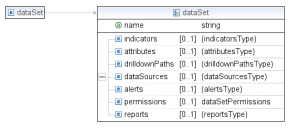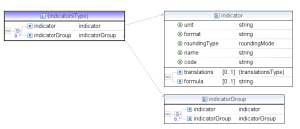You can define the data model either via GUI during the import or in more advanced way using the XML file. The XML definition is submitted to BellaDati's REST API or uploaded via GUI.
Basic concept
XML definition can be applied to objects, the data model consists of:
- dataset - dataset is a virtual cube consisting of attributes and indicators
- attributes - attribute is descriptor of indicator typically strings like ID, name, city etc.
- attribute members - represents the single value of the attribute - e.g. New York, London, Berlin for attribute City.
- indicators - is a data column containing computational data - prices, amounts etc.
On this page:
XML configuration file structure
As described above, data model contains of data set definition including attributes and indicators. Each data set can be also connected to external data source. Following example illustrates how to do it:
<?xml version="1.0" encoding="UTF-8" standalone="yes"?>
<ns2:dataSet xmlns:ns2="http://www.belladati.com/api/v1.0" name="CRM - opportunities">
<indicators>
<indicator code="M_AMOUNT" name="Amount"/>
<indicator code="M_PROBABILITY" name="Probability"/>
</indicators>
<attributes>
<attribute code="L_CITY" name="City"/>
<attribute code="L_ID" name="Id"/>
<attribute code="L_NAME" name="Name"/>
<attribute code="L_OFFICE" name="Office"/>
<attribute code="L_PRODUCT" name="Product"/>
<attribute code="L_STATUS" name="Status"/>
</attributes>
<dataSources>
<dataSource name="SQL data source">
<sql dbType="MYSQL">
<columns>
<timeColumn localeString="cs" format="dd.MM.yyyy" index="0" name="Date"/>
<attributeColumn code="L_ID" index="1" name="Id"/>
<attributeColumn code="L_NAME" index="2" name="Name"/>
<attributeColumn code="L_OFFICE" index="3" name="Office"/>
<attributeColumn code="L_PRODUCT" index="4" name="Product"/>
<attributeColumn code="L_STATUS" index="5" name="Status"/>
<attributeColumn code="L_CITY" index="6" name="City"/>
<indicatorColumn code="M_AMOUNT" index="7" name="Amount"/>
<indicatorColumn code="M_PROBABILITY" index="8" name="Probability"/>
</columns>
<overridingTimeColumnDate>2010-12-17</overridingTimeColumnDate>
<properties>
<entry name="SQL" value="select * from crm_opportunities"/>
</properties>
<connectionParameters>
<entry name="database" value="crm_db"/>
<entry name="host" value="host_address"/>
<entry name="password" value="password"/>
<entry name="user" value="user"/>
</connectionParameters>
</sql>
</dataSource>
</dataSources>
<permissions>
<owner>support@belladati.com</owner>
</permissions>
</ns2:dataSet>
Content of the XML configuration file corresponds with the XSD schema belladati_1_0.xsd.
Creating data set
Data set is defined by <dataSet> tag.
Example
<ns2:dataSet xmlns:ns2="http://www.belladati.com/api/v1.0" name="CRM - opportunities"> ... </ns2:dataSet>
Tag attribures
name |
type |
required |
description |
|---|---|---|---|
|
string |
true |
Name of the data set |
Nested tags
name |
type |
cardinality |
description |
|---|---|---|---|
|
complex |
0..1 |
Encloses the indicators and indicator groups |
|
complex |
0..1 |
Encloses the attributes |
|
complex |
0..1 |
Encloses the possible drilldown paths |
|
complex |
0..1 |
Defines the data source |
|
complex |
0..1 |
Encloses the alerts |
|
complex |
0..1 |
Encloses the permissions |
|
complex |
0..1 |
Encloses the reports definitions |
Creating indicators and indicators groups
Indicator is represented by single object or is a part of a group of indicators. Indicators and groups are enclosed by <indicators> tag.
Creating indicator
Single indicator is represented by <indicator> tag.
Example
<indicators>
<indicator code="M_AMOUNT" name="Amount" unit="USD"/>
<indicator code="M_COUNT" name="Count"/>
</indicators>
Tag attribures
name |
type |
required |
description |
|---|---|---|---|
|
string |
true |
Indicator's code. Must start with "M_" prefix and is unique within the dataset. |
|
string |
true |
Name of the indicator |
|
string |
false |
Unit of the indicator |
|
string |
false |
Rounding mode - see http://download.oracle.com/javase/6/docs/api/java/math/RoundingMode.html for more information |
|
string |
false |
Defines how the value of the indicator should be formatted |
Nested tags
|
complex |
0..1 |
Encloses the indicator's translation |
|
CDATA value |
0..1 |
Defines the formula, if the indicator's value is evaluated |
Creating indicator with formula
Example
<indicators>
<indicator code="M_AMOUNT" name="Amount" unit="USD"/>
<indicator code="M_COUNT" name="Count"/>
<indicator code="M_RATE" name="Rate">
<formula>M_AMOUNT / M_COUNT</formula>
</indicator>
</indicators>
Creating indicator's translation
Translation for indicator is supported by nested tag <translation>. Translations are compliant with indicators and indicator groups as well.
Example
<indicators>
<indicator code="M_AMOUNT" name="Amount" unit="USD">
<translations>
<translation locale="de" value="Translated value"/>
</translations>
</indicator>
</indicators>
Tag attribures
name |
type |
required |
description |
|---|---|---|---|
|
string |
true |
Locale of the translation |
|
string |
true |
Translated value |
Creating indicator group
If you want more structured and hierarchical organized indicators, you can define it within the indicator group. Each indicator group consists of single indicators or nested indicators groups. Indicator group definition is enclosed in tag <indicatorGroup>.
Example
<indicators>
<indicatorGroup name="group">
<indicator code="M_INDICATOR" name="indicator"/>
<indicatorGroup name="sub-group">
<indicator code="M_SUBGROUP_INDICATOR" name="sub-group indicator"/>
</indicatorGroup>
</indicatorGroup>
</indicators>
Tag attribures
name |
type |
required |
description |
|---|---|---|---|
|
string |
true |
Indicator's code. Must start with "M_" prefix and is unique within the dataset. |
|
string |
true |
Name of the indicator |
|
string |
false |
Unit of the indicator |
|
string |
false |
Rounding mode - see http://download.oracle.com/javase/6/docs/api/java/math/RoundingMode.html for more information |
|
string |
false |
Defines how the value of the indicator should be formatted |
Nested tags
|
complex |
0..1 |
Nested indicator |
|
complex |
0..1 |
Nested indicator group |
Creating attributes
Attributes entries <attribute> are defined within the <attributes> tag.
Example
<attributes>
<attribute code="L_CITY" name="City"/>
<attribute code="L_ID" name="Id"/>
<attribute code="L_NAME" name="Name"/>
<attribute code="L_OFFICE" name="Office"/>
<attribute code="L_PRODUCT" name="Product"/>
<attribute code="L_STATUS" name="Status"/>
</attributes>
Tag attribures
name |
type |
required |
description |
|---|---|---|---|
|
string |
true |
Attribute's code. Must start with "L_" prefix and is unique within the dataset. |
|
string |
true |
Name of the attribute |
Nested tags
|
complex |
0..1 |
Encloses the attribute's translation (see indicator's translation) |
|
complex |
0..1 |
Encloses the attribute member's translation |
|
complex |
0..1 |
Holds the attribute member's settings, like appearance |
Creating attribute's translation
Translation for attributes is supported by nested tag <translation>.
Example
<attributes>
<attribute code="L_CITY" name="City"/>
<translations>
<translation locale="de" value="Translated value"/>
<translation locale="cs" value="Another translated value"/>
</translations>
</attribute>
</attributes>
Tag attribures
name |
type |
required |
description |
|---|---|---|---|
|
string |
true |
Locale of the translation |
|
string |
true |
Translated value |
Creating member's translation
Example
<attribute code="L_CITY" name="City">
<memberTranslations>
<memberTranslation memberValue="Prague" locale="cs" value="Praha"/>
<memberTranslation memberValue="Prague" locale="de" value="Prag"/>
</memberTranslations>
</attribute>
Defining attribute's appearance
Example
<attribute code="L_CITY" name="City">
<memberSettings>
<memberSetting icon="cs" backgroundColor="#c41019" color="#ffffff" memberValue="Prague"/>
</memberSettings>
</attribute>
Defining drilldown paths
Example
<drilldownPaths>
<pathAttribute code="L_ATTRIBUTE_1">
<pathAttribute code="L_ATTRIBUTE_2"/>
<pathAttribute code="L_ATTRIBUTE_2"/>
</pathAttribute>
</drilldownPaths>


